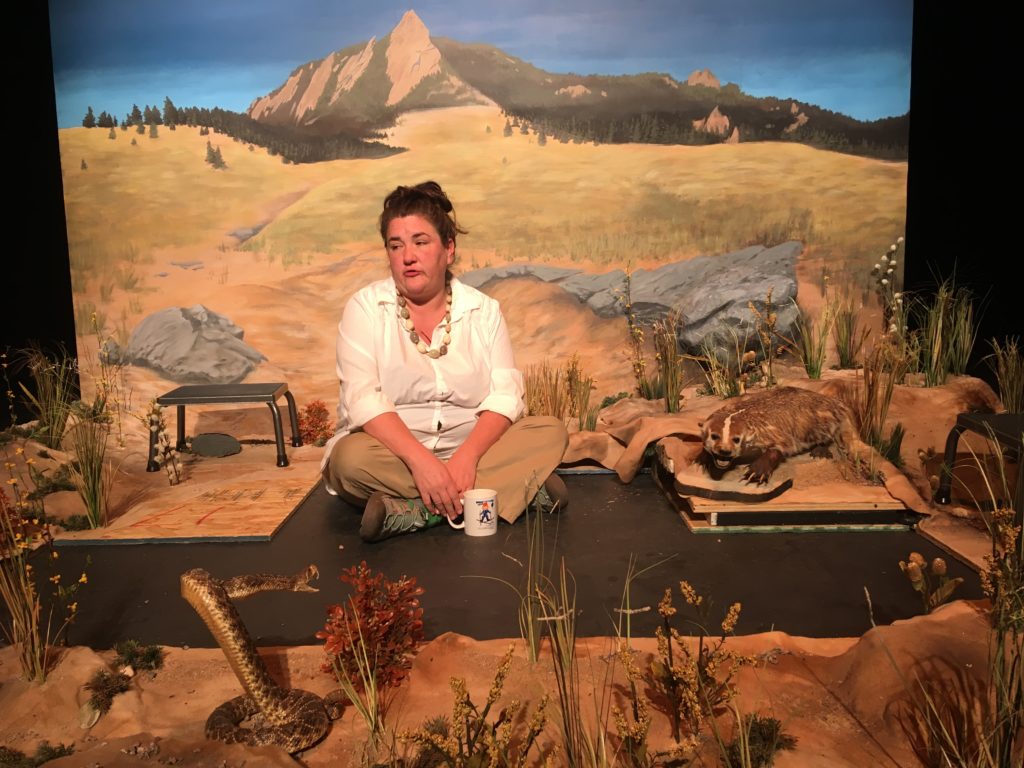The trickster theater troupe will offer “The Grasshoppers” to help get your mind off the coronavirus.
Theater artist Erin Rollman started with the literal.
Rollman was trying to come up with an idea for a show that her Buntport Theater troupe could do after rules imposed to stop the spread of the coronavirus made it impossible to gather audiences and performers inside.
So what’s outside? Grass. And what lives in the grass? Insects.
“I was thinking about the phrase ‘six feet,’” Rollman said, referring to the distance that public health experts advise we keep apart in public to try to stop the pandemic.
Well, kind of thinking about it.
“What little creatures would be out on the lawn that have six feet?”
She settled on grasshoppers. Some might quibble over whether grasshoppers have feet. They definitely have six legs, and a backstory that resonated with Rollman. Grasshoppers are usually shy creatures, but they become ravenous locusts when they’re around their peers. Physical changes accompany the new behaviors, with the creatures growing stronger and changing color.
During the pandemic, Rollman said, humans “can’t get together in big groups without, metaphorically, turning into locusts.”
As is the tradition at Buntport, she turned to colleagues to brainstorm, via Zoom before Denver’s stay-at-home transitioned to safer-at-home orders. Thus was born “The Grasshoppers,” a short play to be performed on a strip of lawn outside Buntport’s theater at 717 Lipan Street in the Lincoln Park neighborhood to audience members watching from their cars. It’s not too much of a spoiler to divulge that Rollman, Erik Edborg, Brian Colonna and Hannah Duggan all will be wearing green grasshopper costumes sewn by Rollman, who is also a Buntport co-founder.
Drive-in style, audiences will hear a pre-recorded script via their cell phones as they watch the four grasshoppers interact. The script sounds like a nature documentary’s narration, but “the learning factor is probably lower,” Colonna acknowledged.
This is, after all, Buntport, whose performers have been described by Denver Post theater critic Joanne Ostrow as “tricksters.”
Colonna said he hopes “The Grasshoppers” will offer a bit of respite from “the monotony some of us have felt in quarantine.”
A performance during a pandemic can’t be all fun. Safety was a priority as “Grasshoppers” developed from an insect egg of an idea to a show. Rollman, Edborg, Colonna and Duggan will keep a social distance on their lawn stage and have minimized sharing of props. Masks will be needed if you plan to roll down your windows during the show because cars will not be six feet from each other. Anyone who would like to see the performance without a car should contact Buntport for details on how that can be done safely (stuff@buntport.com or 720-946-1388). The theater bathrooms will be open during the show, but the performers kept “The Grasshoppers” to 35 minutes in hopes no one will need to go.
The collaborators had to consider whether audiences might be willing to come to a live performance.
Within days of the May announcement of the show’s June 11-27 run, the eight available parking spaces were reserved (on a pay-what-you-can basis) for each of the 12 performances initially scheduled. Buntport is working out a schedule for additional shows, which will be announced on its website. Still, even if each car holds five people, the response to “The Grasshoppers” doesn’t compare to the 150 seats inside the Buntport.
While shops and restaurants have started to reopen under restrictions, it’s unclear when theaters will be welcoming audiences inside and under what guidelines.
For now, “a closed room with 150 people … doesn’t seem cool,” said Sam Schmitz, another member of the Buntport troupe.
Schmitz said her theater has some loyal fans who are used to coming as often as once a month. While it’s not quite the same as the pre-coronavirus performances, “The Grasshoppers” offers something more than the online material Buntport has recently offered.
“I personally think there is something about live theater you can’t always translate to online,” Edborg said.
Windshields will be between the performers and the audience, and the actors won’t be speaking during “The Grasshoppers.” But without bright theater lights, Rollman expects to be able to see each audience member, something she’s rarely able to do from stage.
“We can connect in a different way,” she said.
“This is its own thing. It’s not a replacement for a show that you can see inside a theater. We’re trying to make it as intimate and fun as we can,” Rollman said. “I suspect that even though we have barriers, it will feel emotional.”
Donna Bryson- June 1st 2020 Denverite
Check this link for great photos with the original article post








